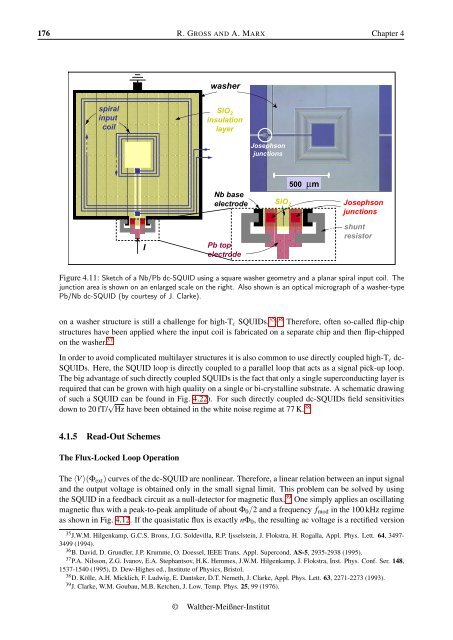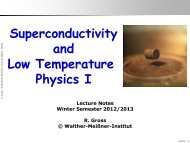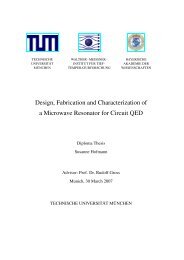Applied Superconductivity - Walther Meißner Institut - Bayerische ...
Applied Superconductivity - Walther Meißner Institut - Bayerische ...
Applied Superconductivity - Walther Meißner Institut - Bayerische ...
- No tags were found...
You also want an ePaper? Increase the reach of your titles
YUMPU automatically turns print PDFs into web optimized ePapers that Google loves.
176 R. GROSS AND A. MARX Chapter 4washerspiralinputcoilSiO 2insulationlayerJosephsonjunctionsNb baseelectrodeSiO 2500 µmJosephsonjunctionsIPb topelectrodeshuntresistorFigure 4.11: Sketch of a Nb/Pb dc-SQUID using a square washer geometry and a planar spiral input coil. Thejunction area is shown on an enlarged scale on the right. Also shown is an optical micrograph of a washer-typePb/Nb dc-SQUID (by courtesy of J. Clarke).on a washer structure is still a challenge for high-T c SQUIDs. 35,36 Therefore, often so-called flip-chipstructures have been applied where the input coil is fabricated on a separate chip and then flip-chippedon the washer. 37In order to avoid complicated multilayer structures it is also common to use directly coupled high-T c dc-SQUIDs. Here, the SQUID loop is directly coupled to a parallel loop that acts as a signal pick-up loop.The big advantage of such directly coupled SQUIDs is the fact that only a single superconducting layer isrequired that can be grown with high quality on a single or bi-crystalline substrate. A schematic drawingof such a SQUID can be found in Fig. 4.22). For such directly coupled dc-SQUIDs field sensitivitiesdown to 20 fT/ √ Hz have been obtained in the white noise regime at 77 K. 384.1.5 Read-Out SchemesThe Flux-Locked Loop OperationThe 〈V 〉(Φ ext ) curves of the dc-SQUID are nonlinear. Therefore, a linear relation between an input signaland the output voltage is obtained only in the small signal limit. This problem can be solved by usingthe SQUID in a feedback circuit as a null-detector for magnetic flux. 39 One simply applies an oscillatingmagnetic flux with a peak-to-peak amplitude of about Φ 0 /2 and a frequency f mod in the 100 kHz regimeas shown in Fig. 4.12. If the quasistatic flux is exactly nΦ 0 , the resulting ac voltage is a rectified version35 J.W.M. Hilgenkamp, G.C.S. Brons, J.G. Soldevilla, R.P. Ijsselstein, J. Flokstra, H. Rogalla, Appl. Phys. Lett. 64, 3497-3499 (1994).36 B. David, D. Grundler, J.P. Krumme, O. Doessel, IEEE Trans. Appl. Supercond. AS-5, 2935-2938 (1995).37 P.A. Nilsson, Z.G. Ivanov, E.A. Stephantsov, H.K. Hemmes, J.W.M. Hilgenkamp, J. Flokstra, Inst. Phys. Conf. Ser. 148,1537-1540 (1995), D. Dew-Highes ed., <strong>Institut</strong>e of Physics, Bristol.38 D. Kölle, A.H. Micklich, F. Ludwig, E. Dantsker, D.T. Nemeth, J. Clarke, Appl. Phys. Lett. 63, 2271-2273 (1993).39 J. Clarke, W.M. Goubau, M.B. Ketchen, J. Low. Temp. Phys. 25, 99 (1976).© <strong>Walther</strong>-Meißner-<strong>Institut</strong>
















